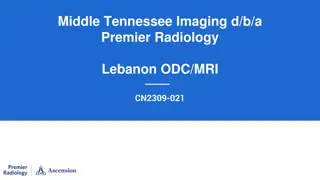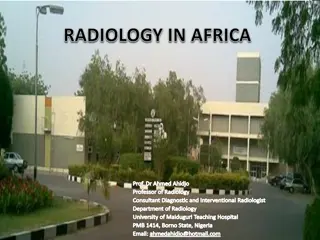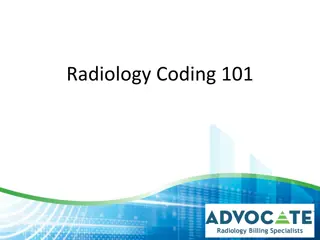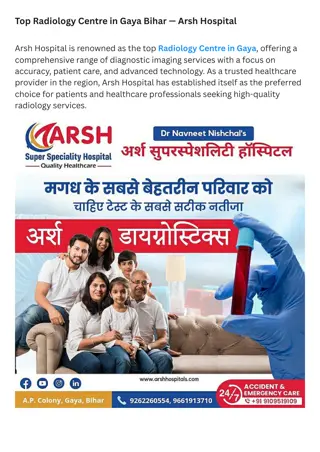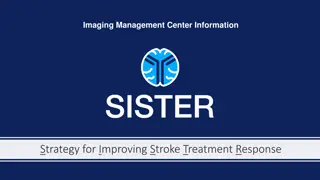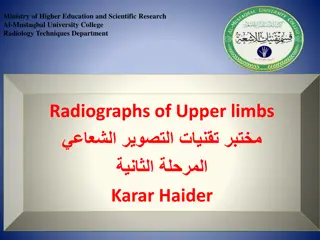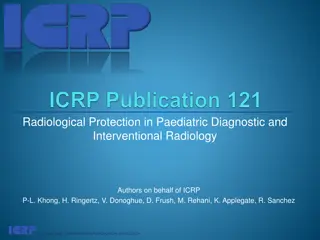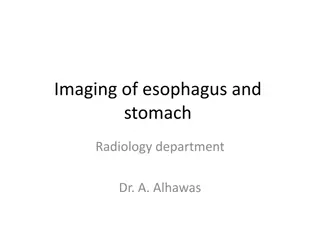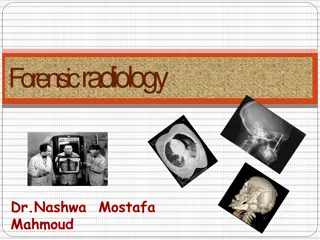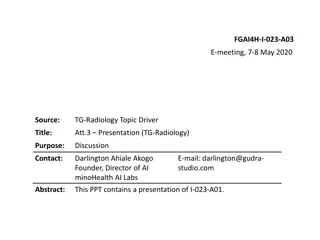Introduction to Radiology: Imaging Modalities and Techniques
Radiology is a medical specialty that utilizes various imaging modalities such as X-Ray, MRI, CT, and Ultrasound to diagnose and treat patients. This field involves the supervision, performance, and interpretation of imaging studies, with findings reported to referring physicians. Radiology also involves the use of contrast media to enhance imaging quality. X-Ray and Fluoroscopy are important techniques in radiology that use ionizing radiation for imaging, with advantages and disadvantages to consider. Understanding the basics of image generation, imaging vocabulary, and limitations is crucial in interpreting radiological findings.
Download Presentation

Please find below an Image/Link to download the presentation.
The content on the website is provided AS IS for your information and personal use only. It may not be sold, licensed, or shared on other websites without obtaining consent from the author. Download presentation by click this link. If you encounter any issues during the download, it is possible that the publisher has removed the file from their server.
E N D
Presentation Transcript
Basic information & introduction to Radiology Radiology Team 438 Lecture 1 Objectives Introduce the various Medical Imaging Modalities Understand the basics of image generation Relate imaging to gross anatomy Appreciate constraints and limitations Develop imaging vocabulary in the interpretation Important Extra Doctor s Notes Female slides male slides Color Index: Team Leaders Omar Aldosari Leena Alnassar Shahd Alsalamh Editing file
Personal history Chief complaint/ Duration History of present illness Past medical history Past surgical history Medication/aller gies Family history Social history Obstetric history
Radiology Medical specialty that supervises, perform and interprets imaging studies. Reports findings to referring physicians to help in the patients management. Medical specialty that use medical imaging technologies to diagnose and treat patients. What is Radiology? Diagnostic Modalities used in radiology Magnetic Resonance Imaging (MRI) Nuclear Medicine (NM) Computed Tomography (CT) plain X-Ray Angiography (ANG) Ultrasound (US) Which of these modalities use ionizing radiation? X-Ray CT Nuclear medicine Contrast Media Added contrast in the body Natural contrast in the body Barium sulfate (non water soluble) safe for GI tract, given orally because it precipitates and cause blocking of the vessels if given IV Iodine (water soluble) can be given as IV Air Fat Bone X-RAY It is a form of Electromagnetic energy that travel at the speed of light. Discovered and named by Dr. W. C. R entgen at University of W rzburg, 1895. X-Rays are emitted and detected in cassette generating, either a hard copy film or a digital image. Image key = shades (Densities) (Q:where on this image have x-rays passed through the body to the greatest degree?lungs) Electromagnetic energy wave spectrum Gamma Rays X-rays Visible light Infrared light Microwaves Radar Radio waves Air Fat Soft tissue Bone The higher frequency and shorter wavelength, the higher penetration ability 1
X-RAY & Fluoroscopy The X-RAY Beam Interaction Projections (views) are usually described by the path of the x-ray beam. Thus, the term PA (poster anterior) view designates that the beam passes from the back to the front. (standard projection for a routine chest film). X-rays are emitted and detected in cassette which generate either a hard copy film or a digital image 1) Pass all the way through the body: Render the film DARK (BLACK shadow) Radio-LUCENT Low atomic number, eg; air Air has a low atomic number X-rays get through image is DARK 2) Be deflected, scattered or absorbed: Render the film LIGHT (WHITE shadow) Radio-OPAQUE high atomic number, eg; bone / Fat / Soft tissue/fluid /Metal / Mineral Bone has a high atomic number X-Rays are blocked image is LIGHT Advantages Disadvantages Ionizing Radiation. can be carcinogenic / to the fetus mutagenic or even lethal Relatively insensitive Requires patient cooperation Widely available Inexpensive Doesn t require advanced technologist knowledge Can be performed quickly Can be portable FLUOROSCOPY A dynamic contrast study, (dynamic) real-time imaging, utilizes image intensifier. It s a combination of: X-Rays Contrast agents Technique Real-time imaging Using intensifier dynamic, detect the movement of the contrast fluid in certain organs e.g. (to assess esophagus leakage after swallow in the GIT) Using intensifier: to magnify the X- Rays without increasing the amount of radiations for patient s safety. since Fluoroscopy study is continuous it has more exposure to radiation. but, using an intensifier leads to less energy intensity but still have a good image. Uses of FLUOROSCOPY GIT imaging Angiography Foreign body removal Musculoskeletal Intraoperative (during surgery) Genitourinary imaging commonly used for recurrent UTIs, vesicoureteral refluxObstructions, dilatations, collecting system abnormalities (e.g. dysphagia, peristalsis) 2
FLUOROSCOPY and CT Advantages Disadvantages Widely available. Inexpensive Functional and anatomic imaging. No sedation required Requires ingestion/injection of contrast medium. Patient cooperation. Radiological hazard Time consuming It is time consuming because we are following contrast agent inside organs COMPUTED TOMOGRAPHY (CT) How Does CT Works? 1. Rotating an X-Ray tube with the X-Ray detector, & the patient will go through these rays 2. cross-sectional images (like slices) is received (Axial) from the body. Each slice is an image itself 3. Data displayed in multiple window settings (lungs parenchyma, bone, etc.) 4. these images are reconstructed to create other images from different views (e.g. coronal) which are 3D images 5. To show coronal (frontal) or Sagittal images, data are manipulated (reconstructed) by a computer Relies on X-Rays transmitted through the body that differs from conventional Radiography (plane X-Ray) in that a more sensitive X-Ray detection system is used. It has the capability to measure the density by analyzing the chemical component of tissue, Hounsfield Unit (HU) Density Density is measured by Hounsfield Unit (HU) CT has very small differences in X-Ray absorption values compared with conventional radiography; the range of densities recorded is increased approximately 10-fold. So, gradations of density within soft tissues can be recognized, e.g. brain substance from cerebrospinal fluid, or tumor from surrounding normal tissues. Soft Tissue: 20-80 Blood: 45- 75 Bone/Ca: >100->1000 Air: -1000 Fat: -150 Water: 0 3
FLUOROSCOPY COMPUTED TOMOGRAPHY Different Windows Wide window Narrow window to visualize more structure within a certain organ such as bronchi, vessels and alveoli in the lung (Lung window) (Bone to visualize cortex, medulla and trabeculae) to visualize certain structures within certain region such as major vessels and heart in mediastinum Vascular structures (mediastinum window) Uses of CT Neuroimaging: Emergency: Acute head trauma, acute intracranial hemorrhage. Low sensitivity for: Early ischemic stroke. Intracranial metastatic disease. White matter degenerative disease Head and neck imaging: Soft tissue of neck, paranasal sinuses, temporal bone, & orbital wall imaging Body imaging: Chest, Abdomen, Pelvis (with enteric and IV contrast) Pulmonary nodules, Renal calculi (without contrast) Acute appendicitis (with enteric and IV contrast) Acute Abdomen: Decrease rate of false laparotomy Trauma spine imaging: (Cervical, thoracic, lumbar) It can miss fractures. Other osseous imaging: pelvis and extremities Vascular imaging: CT angiography I.e. Coronary arteries. Specialized protocols: Liver masses, pancreatic tissue, renal masses, and adrenal masses Advantages Disadvantages Can give: Cross sectional, Sagittal and Coronal Images More sensitive Expensive High Radiation So, don t request a CT scan unless needed, and we can't use it for a pregnant women unless absolutely necessary One brain CT scan radiation = 200 X-Ray radiation One pelvic CT radiation = 400 X- Ray radiation 4
MRI MRI T1 weighted (T1WI). (Fat whit) ( Fluid dark) (Subacute hemorrhage white) T2 weighted (T2WI), (Fluid whit),( Fat less white compared to T1 weighted) Bone appear black on all sequences. Air also appear black on all sequences. On Flair fluid appear jet black. Very good for detection of demyelination plaques and haemorrhages MRI contrast agent. Gadolinium DTPA (Ethylene Triamine Penta acetic acid) is used as contrast agent. It is used with T1W images only. How can we produce an image by the MRI? it depends on the idea of that the body is full of tiny magnets which are the atoms (Ex: hydrogen atoms,markedly abundant in the body organs) then follow these 5 steps: Hydrogen Atoms (protons) in water molecules and lipids: 1. Magnetism affects all protons causes them to line up in one direction. 2. Magnets can be switched on and off to change the direction of the magnetic field. 3. Whenever the water molecule spin around they give a light radio wave. 4. MRI machine can detect it and shows it as images. 5. Like CT, gradation of density within soft tissues can be recognized e.g. brain substance from cerebrospinal fluid, or tumor from surrounding normal tissues. Disadvantages Advantages Expensive. Time consuming. so we can t use it on emergency patient May evoke phobias Claustrophobia No metals allowed Motion. Patients have to keep still during the producer The best soft tissue imaging and pathology (tumors and infections), Show better tissue characteristics Better tissue construction then CT No ionization. Can be done on pregnant women. Images can be obtained in any plane (unlike CT which is taken in axial position) Useful for soft tissue pathology (Tumor, infection) MSK Multisequence play with characteristic abnormal tissues MR angiogram can be perform without introducing contrast media Sagittal Axial Coronal Image key = shades (Intensities) 5
Ultrasound & Nuclear medicine ULTRASOUND Echogenicity Ultrasound is sound waves with frequencies which are higher than those audible to humans (>20,000 Hz). Ultrasonic images also known as sonograms are made by sending pulses of ultrasound into tissue using a probe. The sound echoes off the tissue; with different tissues reflecting varying degrees of sound. The echoes are recorded and displayed as an image to the operator. Needs a well-trained operator. A Doppler ultrasound is a noninvasive test that can be used to estimate the blood flow through the blood vessels, (can be used to differentiate the vessels (renal arteries) from the collecting system in the kidney.) Shadowing Doppler for flow Advantages 1. No radiation (safest for pregnant ladies) 2. Can be portable easily used in ICU 3. Relatively inexpensive Lines: Occur at boundary of two markedly different tissue reflectors (boundary of organs) White areas: Shows echogenic structure which transmit & reflect sound waves e.g. fat, vessels, nodes soft tissue. Black areas: Shows anechoic areas. Fluids transmit but does not reflect sound waves NUCLEAR MEDICINE Uses gamma rays to produce an image (counts or activity). Radioactive nuclide given IV, per OS or per rectum, etc. Rays emitted from the patient. Physiological imaging (abnormal function, metabolic activity) Poor for anatomical information. Radioactivity stays with the patient until cleared or decayed In the nuclear medicine: the source is from patient while the detector is outside unlike the others source were outside Disadvantages Advantages Evaluation of the functional and anatomical features of the structure Sensitive but not that much specific 6
SUMMARY Advantages Disadvantages information Widely available Inexpensive Doesn t require advanced technologist knowledge Can be performed quickly Can be portable Ionizing Radiation. Relatively insensitive (superimposed structures) Requires patient cooperation The X-RAY Beam Interaction: 1-Pass all the way through the body 2-Be deflected, scattered or absorbed X-RAY Uses: GIT imaging Foreign body removal Musculoskeletal Intraoperative Genitourinary imaging Widely available. Inexpensive Functional and anatomic imaging. No sedation required Requires ingestion/injection of contrast medium. Patient cooperation. Time consuming FLUOROSCOPY Types: Wide window Narrow window Uses: Neuroimaging Head and neck Body imaging Can give: Cross sectional, Sagittal and Coronal Images More sensitive Expensive High Radiation COMPUTED TOMOGRAPHY (CT) The best soft tissue imaging and pathology (tumors and infections). No ionization. Can be done on pregnant women. Images can be obtained in any plane Expensive. Time consuming. so we can t use it on emergency patient May evoke phobias Claustrophobia No metals allowed Motion. MRI sees tissues based upon subatomic characteristics (magnetism). MRI No radiation Can be portable Relatively inexpensive Needs a well-trained operator. Ultrasonic images also known as sonograms are made by sending pulses of ultrasound into tissue using a probe. ULTRASOUND Used for Physiological imaging (abnormal function, metabolic activity) Poor for anatomical information. Radioactivity stays with the patient until cleared or decayed Uses gamma rays to produce an image (counts or activity). NUCLEAR MEDICINE 7
quiz 1-Which of these modalities use ionizing radiation a. Plain X-Ray b. Ultrasound c. Magnetic Resonance Imaging (MRI) d. Nuclear Medicine (NM) 2-body imaging of chest,abdomen,pelvis using CT scan? a. With IV contrast only b. With enteric and IV contrast c. Without enteric d. Without contrast 3-Skeletal appearance on x-ray image is? A)Dark grey B) Dark C) Bright grey D) White 5-What waves are used in fluoroscopy ? A)X-rays B) Gamma-rays C) CT D) Alpha 4--Which of the following axises will appear by direct CT scan? A) Axial B) Sagittal C) Coronal D) Oblique 6-One of the specialized protocols for the uses of CT SCAN? a. Pancreatic tissue b. Pulmonary nodule c. Acute appendicitis d. Renal calculi 7-High atomic number substances will appear ...in x-ray? a. Light b. Dark Extra questions Extra questions 7)A 6)A 5)A 4)A 3)D 2)B 1)a & d Answers 8



